Introduction to 802.11ax High-Efficiency Wireless
Updated Mar 19, 2019
Overview
802.11ax, also called High-Efficiency Wireless (HEW), has the challenging goal of improving the average throughput per user by a
factor of at least 4X in dense user environments. This new standard focuses on implementing mechanisms to serve more users a
consistent and reliable stream of data (average throughput) in the presence of many other users. This paper will explore the new
mechanisms that will give the popular 802.11ax standard the title of High-Efficiency Wireless.
View the WLAN Suite
Learn more about 802.11ax
Table of Contents
1. Introduction
2. Key Features and Applications
3. Current Challenges to Wi-Fi Throughput in Dense Environments
4. PHY Mechanisms for High Efficiency
5. MAC Mechanisms for High Efficiency
6. 802.11ax Test Challenges
7. Conclusion
8. About NI and the 802.11ax standard
9. References
10. Discover more
Improving User Throughput in Dense User Environments
Introduction
In 2015 the iconic car manufacturer, Ferrari, released a new version of its entry-level model: the Ferrari California T. This sleek sports
car has a 3.9 liter turbocharged V8 engine capable of generating more than 412 KW (553 Horsepower), good for smashing zero to 100
Km/h (0 to 62 mph) in 3.6 seconds. Keeping the foot on the accelerator will propel this engineering marvel to its top speed of 315 Km/h
(196 mph). [1]
Back to top
The Ferrari designers considered many details of the engine, body and interior to make this vehicle a daily driver, while delivering the
most precise handling, fluid motion, and performance at breakneck speeds. That kind of design would certainly make for an
exhilarating – though significantly shorter – daily commute to the office. However, what good would that red Ferrari convertible be on
the heavily congested streets of a large metropolitan area, with mostly stop-and-go traffic?
Today many people find themselves in that kind of situation. Perhaps not as privileged to be driving an Italian sports car, but able to
enjoy blazing fast wireless connectivity links. Consider that the first 802.11b Wi-Fi standard (1999), had a top link speed of 11 Mbps. A
good first step, but significantly slower than a wired connection. Then a few years later the 802.11a/g revision (2003) increased the
speed to 54 Mbps with the introduction of Orthogonal Frequency Division Multiplexing (OFDM) technology.
The next link speed improvement came with 802.11n (2009) presenting users with single stream links up to 150 Mbps. The 802.11ac
revision of the standard (2013) brought with it the possibility of link speeds around 866 Mbps on a single spatial stream with wider
channels (160MHz) and higher modulation orders (256-QAM). Using the specified maximum number of 8 spatial streams, this
engineering marvel would, in theory, reach its top speed of 6.97 Gbps. In theory, using 802.11ac is the equivalent of replacing your
bicycle or even your family sedan with a souped-up Ferrari.
�
However, speeds approaching 7 Gbps might only be achievable in the controlled race-track environment of the RF lab. In reality, users
commonly experience frustratingly slow data traffic when trying to check their email on a public Wi-Fi at a busy airport terminal. A new
revision of the IEEE 802.11 wireless LAN standard – 802.11ax – seeks to remedy exactly this precise situation.
802.11ax, also called High-Efficiency Wireless (HEW), has the challenging goal of improving the average throughput per user by a
factor of at least 4X in dense user environments. Looking beyond the raw link speeds of 802.11ac, this new standard implements
several mechanisms to serve more users consistent and reliable data throughput in crowded wireless environments.
Key Features and Applications
High-Efficiency Wireless includes the following key features:
Back to top
Backwards compatible with 802.11a/b/g/n/ac
Increase 4X the average throughput per user in high-density scenarios, such as train stations, airports and stadiums.
Data rates and channel widths similar to 802.11ac, with the exception of new Modulation and Coding Sets (MCS 10 and 11) with
1024-QAM.
Specified for downlink and uplink multi-user operation by means of MU-MIMO and Orthogonal Frequency Division Multiple Access
(OFDMA) technology.
Larger OFDM FFT sizes (4x larger), narrower subcarrier spacing (4X closer), and longer symbol time (4X) for improved robustness
and performance in multipath fading environments and outdoors.
Improved traffic flow and channel access
Better power management for longer battery life
High-Efficiency Wireless also serves the following target applications:
Cellular data offloading: By 2020, 38.1 exabytes Wi-Fi offload traffic will be generated each month, continuing to exceed projected
monthly mobile/cellular traffic (30.6 exabytes). [2] That’s equivalent to moving more than 6000 Blue-ray movies per minute on
these networks.
Environments with many access points and a high-concentration of users with heterogeneous devices (Airport Wi-Fi ≠ Home Wi-
Fi)
Outoors/outdoors mixed environments.
�
Figure 1. Example scenario of a stadium with high user density and mixed environments targeted for
802.11ax deployment
Current Challenges to Wi-Fi Throughput in Dense Environments
The 802.11 protocol uses a carrier sense multiple access (CSMA) method in which the wireless stations (STA) first sense the channel
and attempt to avoid collisions by transmitting only when they sense the channel to be idle. That is, when they don’t detect any 802.11
signals. When an STA hears another one, it waits for a random amount of time for that STA to stop transmitting before listening again
for the channel to be free. When they’re able to transmit, STAs transmit their whole packet data.
Back to top
Wi-Fi STAs may use Request to Send/Clear to Send (RTS/CTS) to mediate access to the shared medium. The Access Point (AP) only
issues a CTS packet to one STA at a time, which in turn sends its entire frame to the AP. The STA then waits for an acknowledgement
packet (ACK) from the AP indicating that it received the packet correctly. If the STA doesn’t get the ACK in time, it assumes the packet
collided with some other transmission, moving the STA into a period of binary exponential backoff. It will try to access the medium and
re-transmit its packet after the backoff counter expires.
�
Figure 2. Clear Channel Assessment Protocol
Although this Clear Channel Assessment and Collision Avoidance protocol serves well to divide the channel somewhat equally among
all participants within the collision domain, its efficiency decreases when the number of participants grows very large. Another factor
that contributes to network inefficiency is having many APs with overlapping areas of service. Figure 3 depicts a user (User 1) that
belongs to the Basic Service Set (BSS, a set of wireless clients associated to an AP) on the left. User 1 would contend for access to
the medium with other users in its own BSS and then exchange data with its AP. However, this user would still be able to hear traffic
from the overlapping BSS on the right.
Figure 3. Medium access inefficiency from overlapping BSS
In this case, traffic from the OBSS would trigger User 1’s backoff procedure. This kind of situation results in users having to wait longer
for their turn to transmit, effectively lowering their average data throughput.
�
A third factor to consider is the shared use of wider channels. For example, for 802.11ac operation in North America there is only one
160 MHz channel available, and in Europe only two.
Figure 4. Example 802.11ax channel allocation on the 5GHz band
Planning dense coverage with a reduced number of channels becomes very difficult, forcing network managers to reuse channels in
nearby cells. Without careful and deliberate power management, users will experience co-channel interference, which degrades
performance and negates much of the expected gain from the wider channels. This is especially true for the top data rates of MCS 8, 9,
10, and 11, which are much more susceptible to low signal to noise ratio. Also, on the current implementation of 802.11 networks a 20
MHz channel overlapping an 80 MHz channel will basically render the 80 MHz channel useless, while a user transmits on the narrower
channel. Implementing 802.11ac’s Channel Sharing in a high density network compromises the gains of the 80 MHz channel for
transmissions on a 20 MHz channel.
PHY Mechanisms for High Efficiency
Back to top
PHY Changes
The 802.11ax specification introduces significant changes to the physical layer of the standard. However, it maintains backward
compatibility with 802.11a/b/g/n and /ac devices, such that an 802.11ax STA can send and receive data to legacy STAs. These legacy
clients will also be able to demodulate and decode 802.11ax packet headers – though not whole 802.11ax packets – and backoff when
an 802.11ax STA is transmitting.
The following table highlights the most important changes to this revision of the standard, in contrast to the current 802.11ac
implementation:
802.11ac
802.11ax
�
BANDS
CHANNEL
BANDWIDTH
FFT SIZES
SUBCARRIER
SPACING
OFDM
SYMBOL
DURATION
HIGHEST
MODULATION
DATA RATES
5 GHz
20 MHz, 40 MHz, 80
MHz, 80+80 MHz & 160
MHz
64, 128, 256, 512
2.4 GHz and 5 GHz
20 MHz, 40 MHz, 80
MHz, 80+80 MHz & 160
MHz
256, 512, 1024, 2048
312.5 kHz
78.125 kHz
3.2 us + 0.8/0.4 us CP
12.8 us + 0.8/1.6/3.2 us
CP
256-QAM
1024-QAM
433 Mbps (80 MHz, 1
SS)
6933 Mbps (160 MHz, 8
SS)
600.4 Mbps (80 MHz, 1
SS)
9607.8 Mbps (160 MHz,
8 SS)
Table 1. 802.11ac vs. 802.11ax
Notice that the 802.11ax standard will operate in both the 2.4 GHz and 5 GHz bands. The specification defines a four times larger FFT,
multiplying the number of subcarriers. However, one critical change with 802.11ax is that the subcarrier spacing has been reduced to
one fourth the subcarriers spacing of previous 802.11 revisions, preserving the existing channel bandwidths.
Figure 5. Narrower sub-carrier spacing
�
The OFDM symbol duration and cyclic prefix also increased 4X, keeping the raw link data rate the same as 802.11ac, but improving
efficiency and robustness in indoor/outdoor and mixed environments. Nevertheless, the standard does specify 1024-QAM and smaller
cyclic prefix ratios for indoor environment, which will increase the maximum data rate.
Beamforming
802.11ax will employ an explicit beamforming procedure, similar to that of 802.11ac. Under this procedure, the beamformer initiates a
channel sounding procedure with a Null Data Packet. The beamformee measures the channel and responds with a beamforming
feedback frame, containing a compressed feedback matrix. The beamformer uses this information to compute the channel matrix, H.
The beamformer can then use this channel matrix to focus the RF energy toward each user.
Multi-User Operation: MU-MIMO and OFDMA
The 802.11ax standard has two modes of operation:
Single User: in this sequential mode the wireless STAs send and receive data one at a time once they secure access to the medium, as
this paper has described above.
Multi-User: this mode allows for simultaneous operation of multiple non-AP STAs. The standard divides this mode further into Downlink
and Uplink Multi-user.
Downlink multi-user refers to data that the AP serves to multiple associated wireless STAs at the same time. The existing 802.11ac
standard already specifies this feature.
Uplink multi-user involves simultaneous transmission of data from multiple STAs to the AP. This is new functionality of the
802.11ax standard, which did not exist in any of the previous versions of the Wi-Fi standard.
Under the Multi-User mode of operation, the standard also specifies two different ways of multiplexing more users within a certain area:
Multi-User MIMO and Orthogonal Frequency Division Multiple Access (OFDMA). For both of these methods, the AP acts as the central
controller of all aspects of multi-user operation, similar to how an LTE cellular base station controls the multiplexing of many users. An
802.11ax AP can also combine MU-MIMO with OFDMA operation.
Multi-User MIMO
Borrowing from the 802.11ac implementation, 802.11ax devices will use beamforming techniques to direct packets simultaneously to
spatially diverse users. That is, the AP will calculate a channel matrix for each user and steer simultaneous beams to different users,
each beam containing specific packets for its target user. 802.11ax supports sending up to eight multi-user MIMO transmissions at a
time, up from four for 802.11ac. Also, each MU-MIMO transmission may have its own Modulation and Coding Set (MCS) and a different
number of spatial streams. By way of analogy, when using MU-MIMO spatial multiplexing, the AP could be compared to an Ethernet
switch that reduces the collision domain from a large computer network to a single port.
As a new feature in the MU-MIMO Uplink direction, the AP will initiate a simultaneous uplink transmission from each of the STAs by
means of a trigger frame. When the multiple users respond in unison with their own packets, the AP applies the channel matrix to the
received beams and separates the information that each uplink beam contains. The AP may also initiate Uplink multi-user
transmissions to receive beamforming feedback information from all participating STAs as shown in Figure 7.
�
Figure 6. AP using MU-MIMO beamforming to serve multiple users located in spatially diverse positions
Figure 7. A beamformer (AP) requesting channel information for MU-MIMO operation
Multi-User OFDMA
�
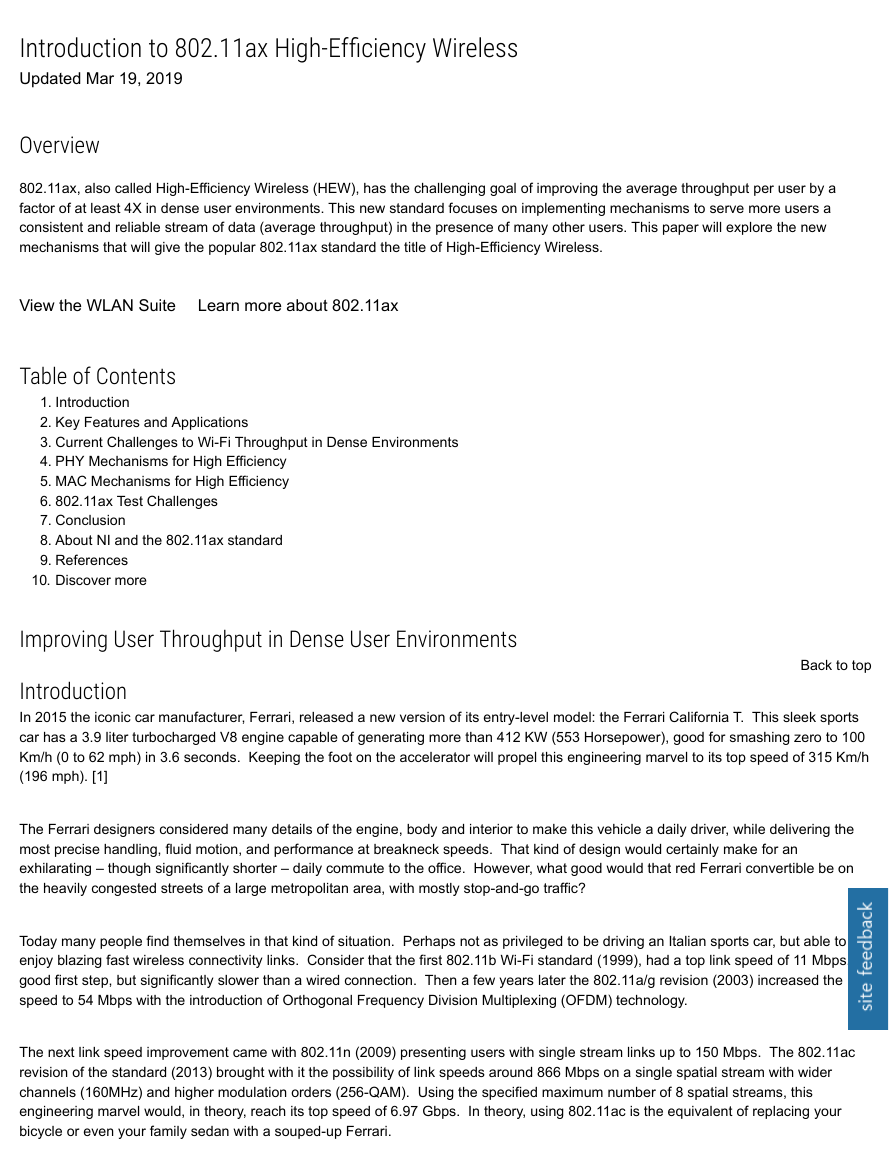



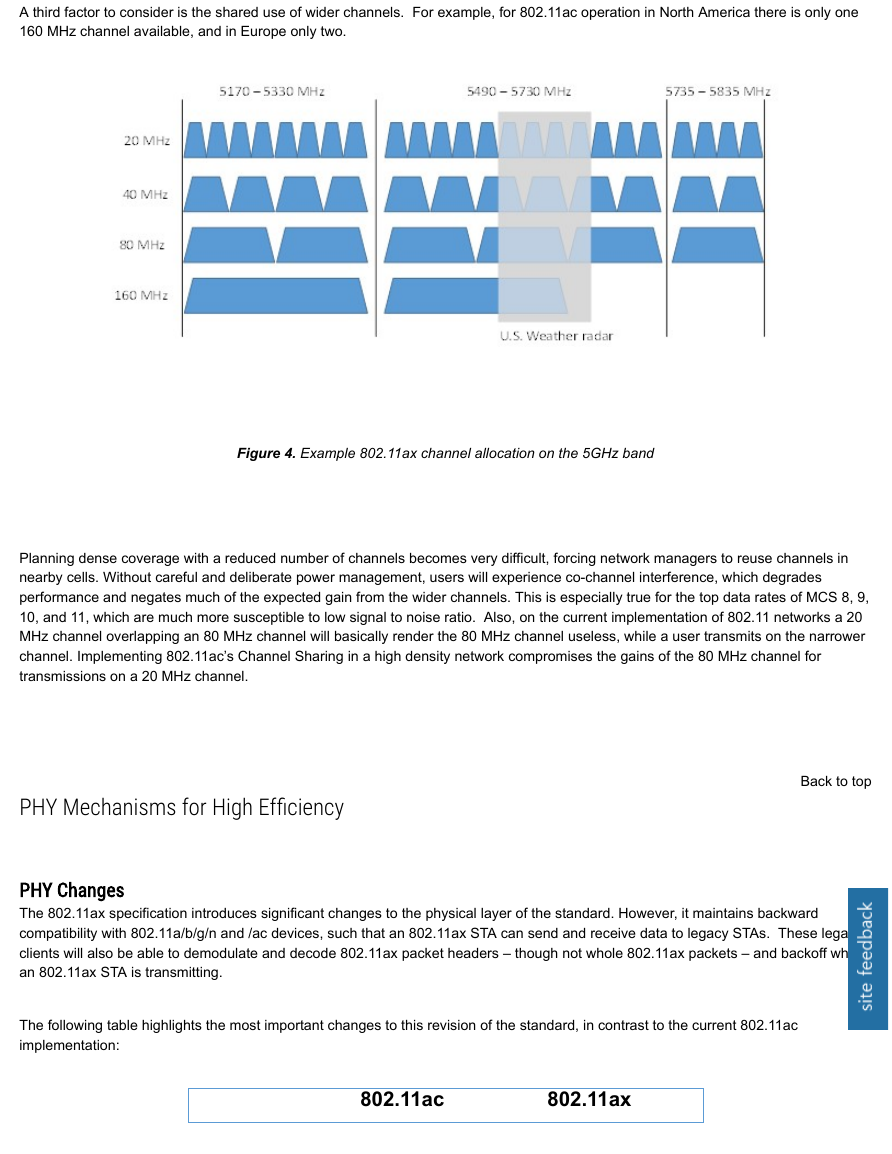
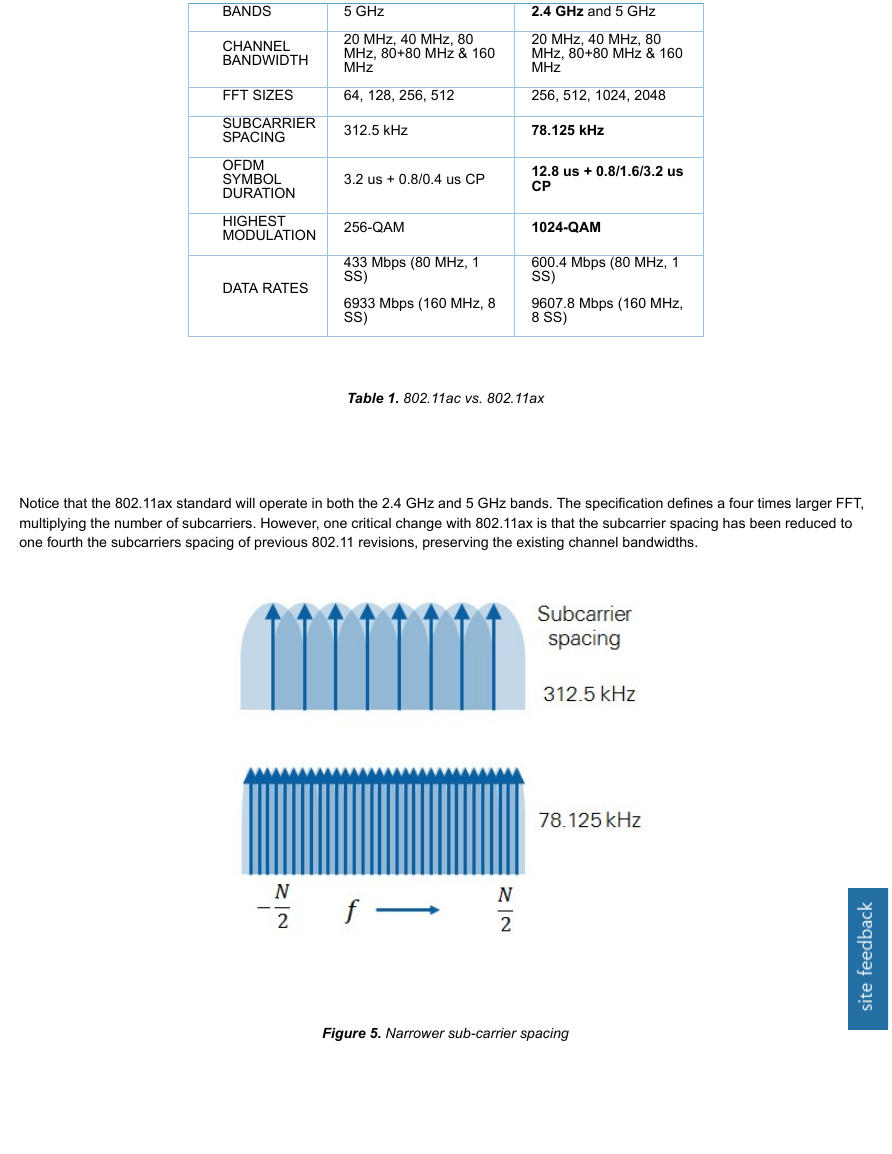
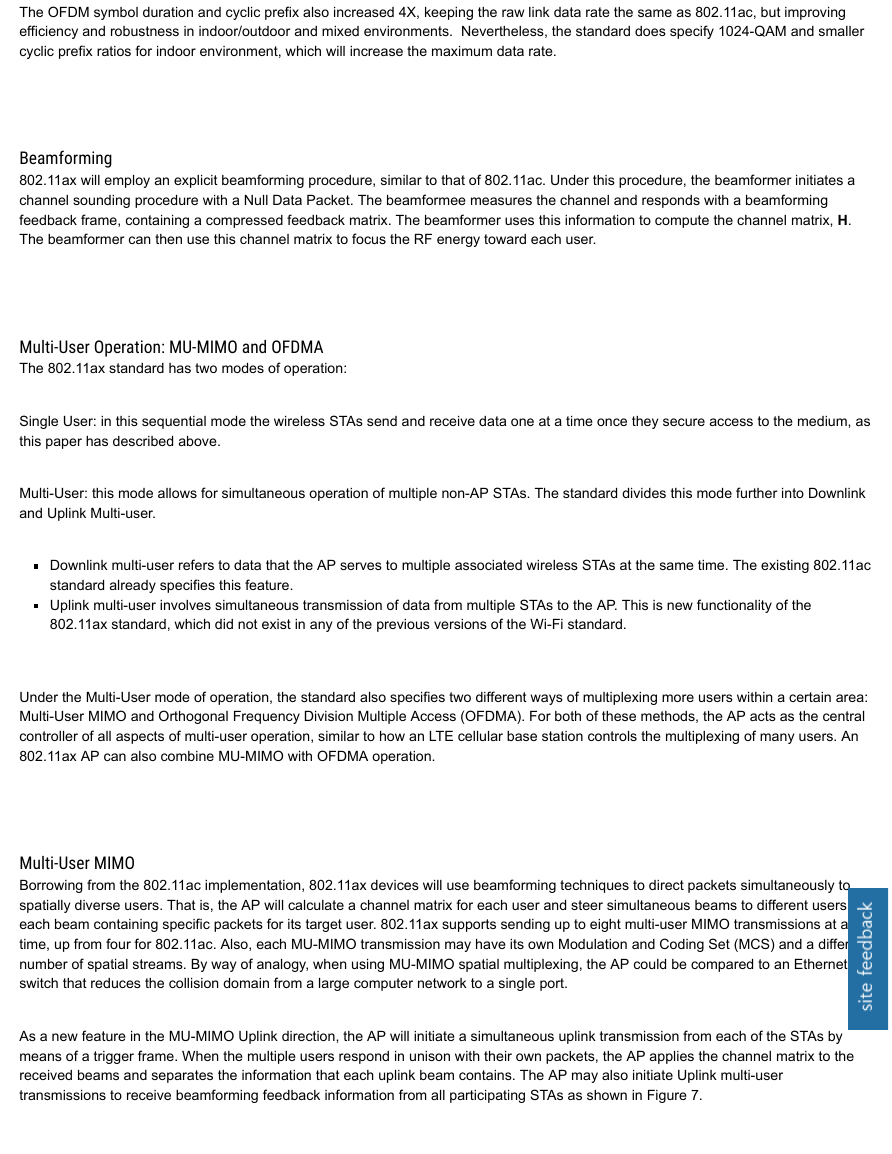
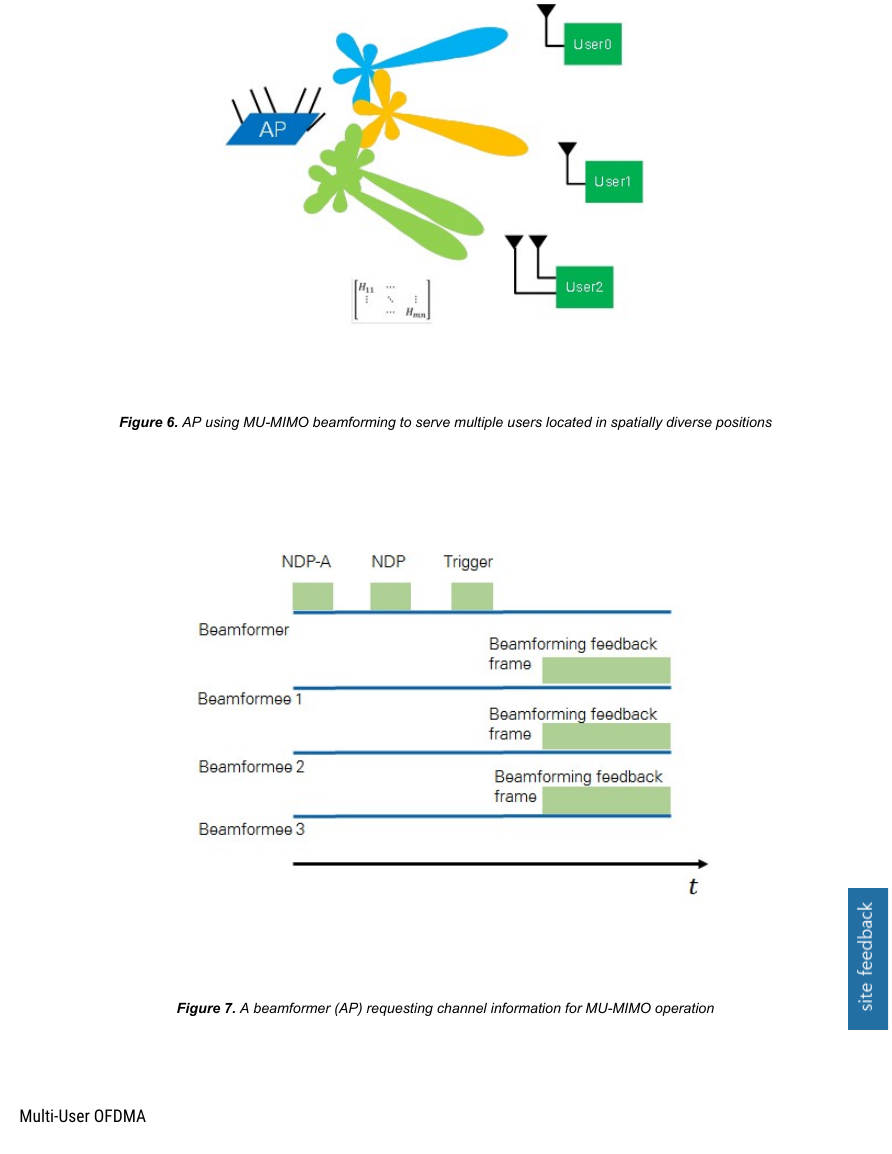








 2023年江西萍乡中考道德与法治真题及答案.doc
2023年江西萍乡中考道德与法治真题及答案.doc 2012年重庆南川中考生物真题及答案.doc
2012年重庆南川中考生物真题及答案.doc 2013年江西师范大学地理学综合及文艺理论基础考研真题.doc
2013年江西师范大学地理学综合及文艺理论基础考研真题.doc 2020年四川甘孜小升初语文真题及答案I卷.doc
2020年四川甘孜小升初语文真题及答案I卷.doc 2020年注册岩土工程师专业基础考试真题及答案.doc
2020年注册岩土工程师专业基础考试真题及答案.doc 2023-2024学年福建省厦门市九年级上学期数学月考试题及答案.doc
2023-2024学年福建省厦门市九年级上学期数学月考试题及答案.doc 2021-2022学年辽宁省沈阳市大东区九年级上学期语文期末试题及答案.doc
2021-2022学年辽宁省沈阳市大东区九年级上学期语文期末试题及答案.doc 2022-2023学年北京东城区初三第一学期物理期末试卷及答案.doc
2022-2023学年北京东城区初三第一学期物理期末试卷及答案.doc 2018上半年江西教师资格初中地理学科知识与教学能力真题及答案.doc
2018上半年江西教师资格初中地理学科知识与教学能力真题及答案.doc 2012年河北国家公务员申论考试真题及答案-省级.doc
2012年河北国家公务员申论考试真题及答案-省级.doc 2020-2021学年江苏省扬州市江都区邵樊片九年级上学期数学第一次质量检测试题及答案.doc
2020-2021学年江苏省扬州市江都区邵樊片九年级上学期数学第一次质量检测试题及答案.doc 2022下半年黑龙江教师资格证中学综合素质真题及答案.doc
2022下半年黑龙江教师资格证中学综合素质真题及答案.doc